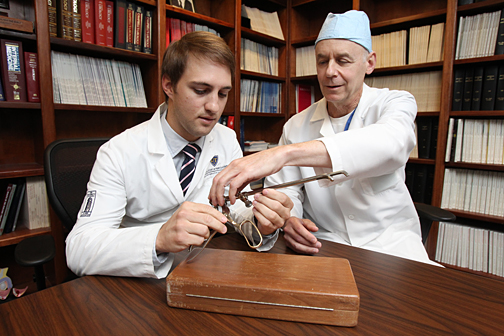The mystery of Dr. Gurdon Buck, it turns out, was no mystery at all.
The noted physician, who died in 1877, had long been a curiosity to Dr. Steven H. Selman, professor and chair of urology in the UT College of Medicine and Life Sciences. Buck made significant clinical contributions in the fields of orthopedics, urology and otolaryngology, which sparked a historical interest Selman sought to share with the right student.

Dr. Steven Selman, right, and Bradley Buck examine an antique lithotrite, a medical instrument Dr. Gurdon Buck probably used to crush bladder stones during surgery.
Selman began looking for Buck’s kin. When he contacted Leonard Buck, a local orthopedic surgeon and graduate of the former Medical College of Ohio, he learned there was no relation to Gurdon Buck. There was, however, a fourth-year medical student in UT’s program — Leonard Buck’s son — who had a healthy appetite for history.
“Out of the blue comes Bradley Buck,” Selman recalled.
Bradley Buck was intrigued by Selman’s side project. Although the St. John’s Jesuit High School graduate was in the midst of his studies, he quickly joined Selman’s pursuit of discovering Gurdon Buck’s history.
Their collaboration reached up the road, as Bradley Buck traveled to the University of Michigan to obtain one of Gurdon Buck’s medical books, and to Cornell University, where archivists supplied medical photographs the elder Buck had taken more than a century earlier. Hours were spent researching online archives.
“The main thing that interested me was the opportunity to work with Dr. Selman,” said Bradley Buck, who hopes to establish a practice in 2017 or 2018. “I’d heard of Buck’s fascia from anatomy classes, but didn’t know anything about the man behind it. There’s one thing in the human body with my name on it. I wanted to learn more.”
Gurdon Buck, he discovered, had been a renaissance physician of sorts. His achievements were diverse — from reconstructive operations on U.S. Civil War veterans, to the development of Buck’s traction, a still-utilized treatment for femur fractures, to Buck’s fascia, a layer of skin covering the penis that was named after him.
“I was amazed by how varied his interests were and how significantly he affected each field,” Bradley Buck noted. “He made huge contributions to orthopedics, urology, plastic surgery, otolaryngology and general surgery.”
Bradley Buck wrote an article titled “Beyond Buck’s Fascia: The Life and Contributions of Dr. Gurdon Buck (1807-1877),” submitted it to Urology, a medical publication, and crossed his fingers.
In April, less than a month later, Buck received word that the piece would be published, a rarity for student-authors’ first submissions. The article is scheduled to appear in an upcoming issue of Urology. Bradley Buck and Selman are credited.
The article has been posted on Urology’s website, but a subscription is required for access. Those interested may email bradley.buck@rockets.utoledo.edu.
Selman hopes the project encourages more students to delve into medical history. “From my perspective, the goal is have students discover the roots of many things they do today and form a connection to those who have come before them.”
Bradley Buck said he spent 30 to 40 hours on the intricacies of Gurdon Buck. “I didn’t treat it like a homework assignment. He was such a dynamic character that the article deserved to be done right.”